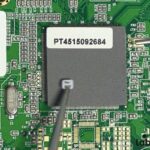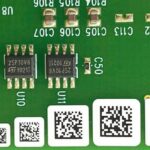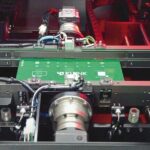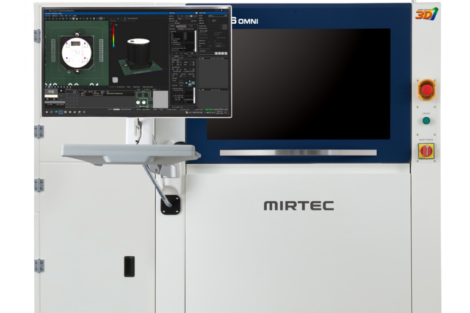The UK is home to a substantial portion of the world‘s contract electronics manufacturing (CEM) sector which produces high volumes of critical high-value electronics like medical devices, automotive and telecoms equipment. This complex, high-mix production landscape has driven an increased emphasis on quality control and traceability – both essential to manufacturers embracing Industry 4.0 practices. It has also led to concerns about product identification processes, with many finding manual product labelling for the identification and monitoring of parts inadequate for today’s stringent demands. Moreover, labour shortages in the UK mean that CEMs are now looking to automate repetitive, manual processes. To address these issues, a growing number of manufacturers are transitioning to automated laser marking systems.
Manual labelling – pros and cons
Manual labelling was previously been seen as a simple and inexpensive option for basic product identification. Workers quickly applied pre-printed stickers by hand or added markings to PCBAs with stencils or ink pens to designate logos, serial numbers, and barcodes. This made manual labelling an appealing starting point when production volumes were smaller and products less complex. As manufacturing has exponentially increased, products have become more sophisticated, and technical specifications have grown more exacting, however, manual labelling has proved limited in meeting the complex requirements of cutting-edge electronics manufacturing.
Undoubtedly manual labelling remains a good option for prototyping and early development. The low cost and flexibility of a simple sticker means labels on prototypes can be applied and modified as designs evolve. This adaptability enables quick iteration without specialised equipment. In a high-volume production environment, however, there are several important drawbacks to manual labelling methods, outlined below.
Human error and inconsistency
Manual label application is subject to human error. Even the most skilled operator will make the occasional mistake – and the probability of this happening increases as production runs get longer. Different operators also apply labels differently. Inconsistencies and inaccuracies in component identification can lead to defective products, recalls, and traceability problems.
Time-consuming
Manually adding individual labels onto components is a slow process, especially with small electronic components. Even for an experienced worker, handling and positioning each tiny label is time consuming. The more labels required per product, the greater the time involved. This process becomes highly labour intensive and can cause a bottleneck in production flows, which significantly decreases manufacturing throughput and efficiency.
Lack of adaptability
Pre-printed labels used in manual labelling processes offer minimal flexibility when design changes are required. Companies using manual labels must discard obsolete label stocks and order new pre-printed labels whenever they want to adjust label content or position. This wastes inventory and requires production downtime during changeovers. With pre-printed labels, unique serial numbers cannot be generated, nor is customisation, or variable data like date codes possible.
Questionable reliability
The adhesives used in manual stick-on labels can fail over time if exposed to humidity, high temperatures, abrasion, or chemicals. Labels can peel, fall off, become illegible or disappear completely – resulting in products with missing or incorrect identification markers. This makes ongoing traceability and warranty tracking difficult.
Restricted options
Manual labels can only be applied on accessible surfaces with enough area for adhesion. Irregular shapes, smaller sizes, and hidden areas restrict where labels can be placed. Only certain materials can be labelled, and these must meet size requirements for human handling. All these constraints limit options for product design and labelling location.
Additionally, manual labelling cannot fulfil the obligations for permanent marks mandated by certain regulatory requirements like unique device identification (UDI). Overall, the limitations and disadvantages inherent to manual labelling make it unsustainable for high-quality electronics production.
Is laser labelling the answer?
Automated and precise, modern laser marking systems bypass the limitations of manual labelling by offering permanent marking capabilities. Although manufacturers may be put off by the initial outlay to purchase the equipment, laser marking has numerous advantages that far outweigh the investment cost. Such systems have become integral to production lines, prompting many CEMs to opt for laser marking technology.
Permanent marks
Lasers create marks by altering the surface structure of materials through ablation, oxidation, melting or other photochemical processes. This means labels become integral, permanent parts of the product and are not just stuck on. Laser marked identification withstands wear, abrasion, temperature extremes and chemical exposure. Electronics OEMs can trace labelled products across their entire lifecycle.
Precision and legibility
Lasers can etch intricate details and small font sizes down to micron levels. Complex machine-readable codes like barcodes can be inscribed with perfect precision and accuracy. This prevents errors in component identification – especially critical for complex miniature electronics parts. Laser labelling is effective on unusual shapes and designs, including on curved, angled or hidden surfaces not reachable using manual methods.
Hands-free
Laser marking is a non-contact process. It does not require physical contact with the PCB surface, unlike ink printing or mechanical engraving methods. The laser imprints by directing focused light energy onto a material to alter its structure without touching it. This non-contact process eliminates any risk of damage, distortion, or stress to delicate electronic components during marking. This enables safe, clean, and damage-free identification of even the most sensitive, densely-packed PCB designs. It can also be applied on various surfaces, from metals and ceramics to laminates and plastics, making it ideal for modern high-mix electronic components.
Easy to integrate
Laser marking methods seamlessly integrate with fully automated production lines and material handling systems. Parts can be precision marked quickly with no manual intervention. Programmable laser systems also enable rapid changeovers between label formats and data variables. This allows for high-throughput production runs without delays.
Adaptable
Laser systems excel at on-demand marking of labels with variable information like dates, times, and serial numbers. Programming is fast and flexible – allowing for quick customer-specific customisation.
Regulatory compliant
Stringent government traceability regulations like UDI require permanent product labels that remain intact over long periods and harsh conditions. Laser marking satisfies labelling permanence regulations that manual methods cannot.
The clear choice for the future?
After considering the advantages and disadvantages of manual and laser labelling, it is evident that laser technology is the best option for the electronics manufacturing of today. The drawbacks and bottlenecks inherent to manual methods hinder quality, throughput, and responsiveness. Laser labelling addresses these shortfalls and facilitates state-of-the-art production.
Laser systems meet the rigorous demands of high-precision Industry 4.0 electronics production, enabling immediate and flexible product identification, intricate coding, automated workflows, and label permanence. As electronics manufacturing processes evolve and smart factories and data-driven production strategies take over, laser labelling can fit in seamlessly. Laser systems interface directly with central automation controls, production databases, enterprise resource planning systems and machine learning platforms, making laser-marked labels essential components of advanced PCBA manufacturing practices.













